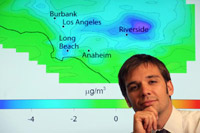Computer Modeling the Effects of Alternative Fuels
 Stephens-Romero is a UC Irvine doctoral candidate in the Advanced Power & Energy Program. His 2060 analysis was published online recently in Environmental Science & Technology. Stephens-Romero is painting the picture of future for our benefit, “For the first time, we can look at these future fuel scenarios and say how they’re going to impact things like ozone and particulate matter, which have severe effects on people’s lungs and quality of life.”
Stephens-Romero is a UC Irvine doctoral candidate in the Advanced Power & Energy Program. His 2060 analysis was published online recently in Environmental Science & Technology. Stephens-Romero is painting the picture of future for our benefit, “For the first time, we can look at these future fuel scenarios and say how they’re going to impact things like ozone and particulate matter, which have severe effects on people’s lungs and quality of life.” He prepared a computer model known as STREET (Spatially & Temporally Resolved Energy & Environment Tool). Here he was predicting a future environment scene, 2060 to be precise. According to Street’s estimates, 75 percent of automobiles in the Greater Los Angeles area would use hydrogen fuel cell that won’t increase green house gases but emit only clean and green water vapor. Environmental measures taken up at various levels would increase the quality of air. Due the various constructive steps by individuals, government bodies and organizations in this prediction greenhouse gas emissions are 60% less than what they are currently in 2009, and levels of microscopic soot and ozone are about 15% and 10% less, respectively.
Stephens-Romero computer model STREET has impressed the California policymakers and auto industry leaders alike. These policy makers and auto industry leaders are already doing a good job of making energy canvass clean and green for transnportation.
Stephens-Romero is raising some valid questions, “We’re transitioning to new technologies. How do we do this while maintaining our lifestyle and keeping our economy robust? We don’t know how these changes could affect the future.” According to him STREET can provide some convincing answers.
STREET is taking its work seriously and accessing most of the variables quite in detail. They are not only taking into consideration the clean and green quotient of fuel but also how the fuel is procured, what processes go on in preparing the fuel, source of fuel, its mode of transportation and what routes it undertakes and last but not the least is the details of fueling stations.
This computer model can provide some answers like what measures we can take to avoid some undesirable results or to get some desirable results. If we want the pollution level not to cross the federal limits, what percentage of the vehicles have to ply on clean and green fuels. Stephens-Romero said, “California policymakers could use the tool in this way to improve air quality in the region.”
Scott Samuelsen is the director of the Advanced Power & Energy Program. He is all praise for Stephens-Romero. According to him, Stephens-Romero’s project is receiving high praise from giants like Toyota, Honda, General Motors, Shell, Air Products, the California Air Resources Board and the California Energy Commission.
Samuelsen elaborates on the project, “The research is well positioned, considering the development of a hydrogen infrastructure is at the crossroads of global climate change, the future of the automobile, the state economy, and California’s leadership in addressing the conflict between energy and the environment.”
Samuelsen is not new to alternative projects. He has already headed the development of UCI’s hydrogen fueling station. This is considered as the most technologically advanced, publicly accessible station in the world. Orange County enjoys the distinctions of having such a station and it is a key constituent of the California Hydrogen Highway Network.
You can return to the main Market News page, or press the Back button on your browser.

